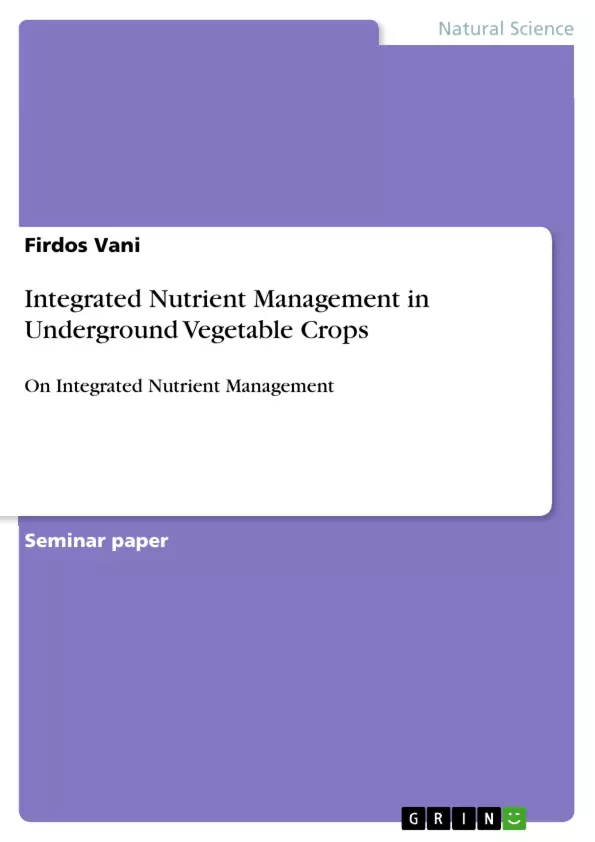This work focuses on horticulture, more precisely on integrated nutrient management in underground vegetable crops.
Vegetable comprises large number of plants, consumed as leaf, fruits, flowers, stem, roots etc. They are rich in nutrients like carbohydrates, proteins, fats, minerals and vitamins. They are mostly cultivated around the year throughout the country. India is the second largest producer of vegetables next to China in the world. It is cultivated in an area of 9575 (‘000’ ha) with production of 166608 (‘000’ MT) with the productivity of 17.40 MT/ha (NHB, 2016). Nowadays, modern agriculture depends heavily on use of chemical fertilizers for boosting crop yield. However, indiscriminate use of fertilizers has an adverse effect on long term soil health and environment which has global attention. The realistic solution is Integrated Nutrient Management system are the combined application of chemical fertilizers, alongwith organic manure, green manure, bio-fertilizer and other organic recyclable materials for crop production.
Vegetable comprises large number of plants, consumed as leaf, fruits, flowers, stem, roots etc. They are rich in nutrients like carbohydrates, proteins, fats, minerals and vitamins. They are mostly cultivated around the year throughout the country. India is the second largest producer of vegetables next to China in the world. It is cultivated in an area of 9575 (‘000’ ha) with production of 166608 (‘000’ MT) with the productivity of 17.40 MT/ha (NHB, 2016). Vegetable growing is the most remunerative enterprise as it is adopted on small and marginal holding with high production in short duration. Being a source of farm income, it creates impact on the agricultural development and economy of the country. Vegetables are cheaper source of minerals, vitamins and fiber with high calorific values. There is an increasing demand of vegetables both for domestic as well as for export, which can earn valuable foreign exchange for country.
Table of Contents
- Introduction
- What is underground Vegetables?
- List of underground vegetable crops
- Bulb crops
- Root vegetable crops
- Tuber vegetable crops
- Spices underground vegetable crops
- Importance of the underground vegetables
- Onion
- Garlic
- Radish
- Carrot
- Beetroot
- Turnip
- Potato
- Sweet potato
- Tapioca
- Elephant foot yam
- TARO (COLOCASIA)
Objectives and Key Themes
This review article focuses on the importance of integrated nutrient management in underground vegetable crops. It examines the role of underground vegetables in human nutrition, exploring their diverse uses and benefits. The article emphasizes the need for sustainable agricultural practices to maintain soil health and the environment.
- Importance of underground vegetables in human nutrition
- Sustainable agricultural practices for underground vegetable crops
- Integrated nutrient management for improved crop yield and soil health
- The role of underground vegetables in food security and economic development
- The impact of chemical fertilizer use on soil health and the environment
Chapter Summaries
- Introduction: The introduction highlights the significance of vegetables in human nutrition, emphasizing their role as a rich source of essential nutrients. It also provides an overview of India's position as a major producer of vegetables, discussing the challenges of modern agriculture reliant on chemical fertilizers.
- What is underground Vegetables?: This section defines underground vegetables, differentiating them from other vegetable types. It provides a comprehensive list of underground vegetable crops categorized into bulb crops, root vegetable crops, tuber vegetable crops, and spices underground vegetable crops, outlining their botanical names, families, and chromosome numbers.
- Importance of the underground vegetables: This section delves into the nutritional value and benefits of specific underground vegetables, including onion, garlic, radish, carrot, beetroot, turnip, potato, sweet potato, tapioca, elephant foot yam, and taro. It discusses their culinary uses, medicinal properties, and potential for improving human health.
Keywords
Key terms and concepts in this review article include underground vegetables, integrated nutrient management, sustainable agriculture, soil health, human nutrition, food security, economic development, chemical fertilizers, organic manure, green manure, bio-fertilizer, and crop yield.
- Arbeit zitieren
- Firdos Vani (Autor:in), 2017, Integrated Nutrient Management in Underground Vegetable Crops, München, GRIN Verlag, https://www.grin.com/document/464858



